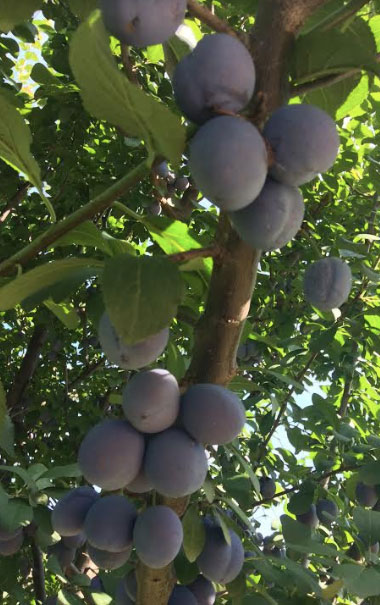Reaping What Was Sown
It's the Nature of Things That Good & Evil Ripen
August 31, 2018
Labor Day, an American holiday, arrives Monday, marking the end of summer vacations and the return of students to school. A "school year" begins. September 1 in the Eastern churches also marks the beginning of a new year, an echo of Rosh Hashanah—Head of the Year (Sept. 10 in the Jewish Calendar his year).

By the end of August, in the Midwest, where I have lived my whole life, fruits are ripening quickly and some crops have been harvested. In my urban "farm" this year we are growing asparagus, yellow wax beans, pole beans, two varieties of cucumbers, kale, leeks, peapods, radishes, black krim tomatoes, arugula, basil and purple basil, chives, dill, oregano, parsley, sage, thyme, 2 grapevines, rhubarb, strawberries, and a plum tree.
The plums are ripening but are not ready for harvest. It takes time. Some crops take more time than others. We put in a second crop of pea pods two weeks ago; an earlier one has been harvested and the plants removed. Two weeks later, after improving the soil, we planted a 10 x 10 square of 100 peas. They're coming up now and (if all goes well) will be producing pods in October. The plums, however, come round once a year.
Living nature moves from seed to plant to fruit. But there is another step for us: harvested grapes are turned into grape jam, cucumbers into pickles, basil into pesto, rhubarb into "red pudding," plums into plums for eating and various plum recipes. The fruit seems to be there for a reason: the plums reach a point later in the fall when each seems to be saying, "Take me!"
I remember an early September afternoon on the Island of Mull in Scotland, walking with a group of Christian pilgrims along a silent and carless road along which wild large ripe blackberries hung from branches reaching out. They seemed "there for the picking" and we obliged. They didn't mind and seemed happy to share the sweetness they had nurtured through the summer months.
Our Lord often used agriculture and aspects of nature-seeds, sparrows, lilies, wheat and tares—to explain eternal truths about "the kingdom of God." Moderns analyze these teachings and regard them as spoken in a "peasant agricultural context" by a simple Galilean rabbi for a peasant audience. What's a poor rabbi to do with an audience lacking a liberal arts education other than stoop to their level?
We, however, live in an industrialized technologically advanced urban society, so these Galilean country parables don't resonate with us. So, was Jesus just a "creature of his culture" who just grabbed what was ready to hand? Or did he who commanded the wind and sea understand that the natural world is more reflective of reality than our world of virtual reality?
The world, from beginning to end, from the edges of the cosmos to the earth's core, from alpha to omega, from fiat lux to the New Jerusalem, is the creation of the Word of God, and that Word permeates all things: sparrows, bacteria, plum trees, babies in the womb, and suckling infants from whom is brought forth "perfect praise." The Word is never randomness; it is always ordered. The "nature" lessons are pure truth about man.
This logos-centric reality, and not some backwoods yet-to-be-enlightened-by-science mindset, is why the Psalmist can sing in faith: "Praise Him sun and moon, all you shining stars . . . mountains and all hills . . . fruit trees and all cedars, beasts and all cattle . . . kings of the earth and all peoples—Let them praise the name of the Lord!" Those September blackberries praised the Lord before us grateful pilgrims.
We are part of the whole created order, sharing material existence with it, but also uniquely created in the image of God. As material creatures, to live, we consume various types of organic matter created through the interaction of sunlight, rain, and soil in combination with a seed that contains a DNA blueprint for its development—a grape, cucumber, tomato, or asparagus seed.
Each one is according to its kind, including the spiritual man. So "a good tree produces good fruit and an evil tree produces evil fruit." Simple. Homespun. Timeless. The appearance of fruit, good or evil, may take time. But when you see it, you know it. "By their fruits ye shall know them." Very applicable today, no?
Yours for Christ, Creed & Culture,

James M. Kushiner
Executive Director, The Fellowship of St. James
—James M. Kushiner is Executive Editor of Touchstone: A Journal of Mere Christianity, and Executive Director of The Fellowship of St. James.







